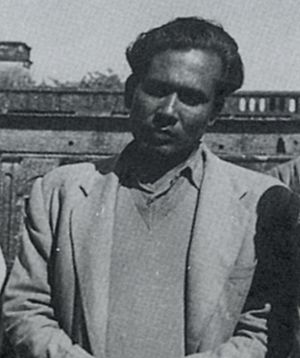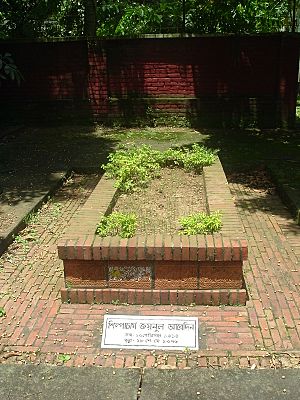Zainul Abedin facts for kids
Quick facts for kids
Shilpacharya
Zainul Abedin
|
|
|---|---|
| জয়নুল আবেদিন | |

Abedin in 1955
|
|
| Born | 29 December 1914 |
| Died | 28 May 1976 (aged 61) Dhaka, Bangladesh
|
| Nationality | Bangladeshi |
| Education |
|
| Known for | Painting, drawing |
|
Notable work
|
|
Zainul Shah Ali Abedin (born December 29, 1914 – died May 28, 1976) was a famous Bangladeshi painter. He was born in Kishoregonj, which was then part of British India and is now Bangladesh. He became very well known in 1944 for his paintings that showed the terrible Bengal famine of 1943.
After the Partition of India, he moved to East Pakistan (now Bangladesh). In 1948, he helped start an art school in Dhaka. This school is now called the Faculty of Fine Arts. Many people call him a legendary Bangladeshi painter. His home country gave him the special title “Shilpacharya”, which means “Great teacher of the arts”. He is seen as the person who started the modern art movement in Bangladesh.
Contents
Early Life and Art Education
Zainul Abedin was born on December 29, 1914. He spent much of his childhood near the beautiful Brahmaputra River. This river later became a big inspiration for his art. He painted many pictures of the Brahmaputra. In 1938, a series of his watercolor paintings of the river won him a gold medal at a big exhibition in India. This award made him confident to develop his own unique painting style.
In 1933, Abedin joined the Government School of Art in Calcutta (now Kolkata, India). For five years, he learned the British and European styles of art. After he graduated, he even taught at the same school. He was the first Muslim student to get the highest honors from the school. He wanted to create art that felt real and modern.
In 1948, he helped create an art institute in Dhaka. At that time, there were no art schools in the city. This institute quickly became one of the best art schools in Pakistan. He taught many students there, including famous artists like Mansur Rahi, Monirul Islam, and Mohammad Kibria.
After studying at the Slade School of Fine Art in London, he started a new style called the 'Bengali style'. This style used folk art shapes and bright colors. Later, he focused on painting real life, like rural scenes and people's daily struggles. He wanted his art to be both realistic and modern.
Famous Paintings and Themes
Zainul Abedin's most famous works are his sketches from the 1940s, especially those about the famine. His famine paintings, shown in 1944, received a lot of praise. The terrible suffering of people during the Great Famine of Bengal in 1943 deeply affected him.
He made his own ink from burnt charcoal and drew on cheap packing paper. He showed starving people dying on the streets. Abedin didn't just record the famine; he showed its cruel reality through the bony figures of people who were starving to death.
These drawings became powerful symbols of human suffering. They helped him develop a realistic style that focused on people's pain, struggles, and protests. He cared a lot about working-class people and their challenges. His painting Rebel Cow is a great example of this style. He was also part of the Calcutta Group of artists. He painted modern pictures of the Santhal people, like "Two Santhal Women".
In 1970, he visited Palestinian refugee camps in Syria and Jordan. He painted many pictures of the refugees there. He also painted about the 1970 Bhola cyclone that caused a lot of damage in East Pakistan (now Bangladesh).
Role in Liberation Movement
Zainul Abedin was involved in the Bengali Language Movement in East Pakistan. He also played a part in the Bangladesh liberation war movement. He was a leader in the cultural movement to celebrate Bengali identity, which the Pakistan government tried to suppress. In 1969, Abedin painted a long scroll called Nabanna. He used Chinese ink, watercolor, and wax for this painting. It celebrated the ongoing movement for independence.
Later Years and Legacy
In 1974, the University of Delhi in India gave him an honorary degree. In 1975, he started the Folk Art Museum in Sonargaon. He also opened the Zainul Abedin Sangrahashala, a gallery for his own artworks, in Mymensingh. Sadly, in 1982, 17 of the 70 paintings in the Mymensingh gallery were stolen, and only 10 were found later.
Zainul Abedin was married to Jahanara Abedin. He passed away from lung cancer on May 28, 1976, in Dhaka. His last painting was called Two faces, which he finished just before he died. He was buried near the Dhaka University Central Mosque.
His work continues to be celebrated. In 2009, a crater on the planet Mercury was named Abedin after him. His birthday is celebrated in Bangladesh with festivals and art competitions for children. The Zainul Abedin Museum in Mymensingh is dedicated to his art. In December 2019, Google celebrated his 105th birthday with a special Google Doodle.
Images for kids
See also
 In Spanish: Zainul Abedin para niños
In Spanish: Zainul Abedin para niños







